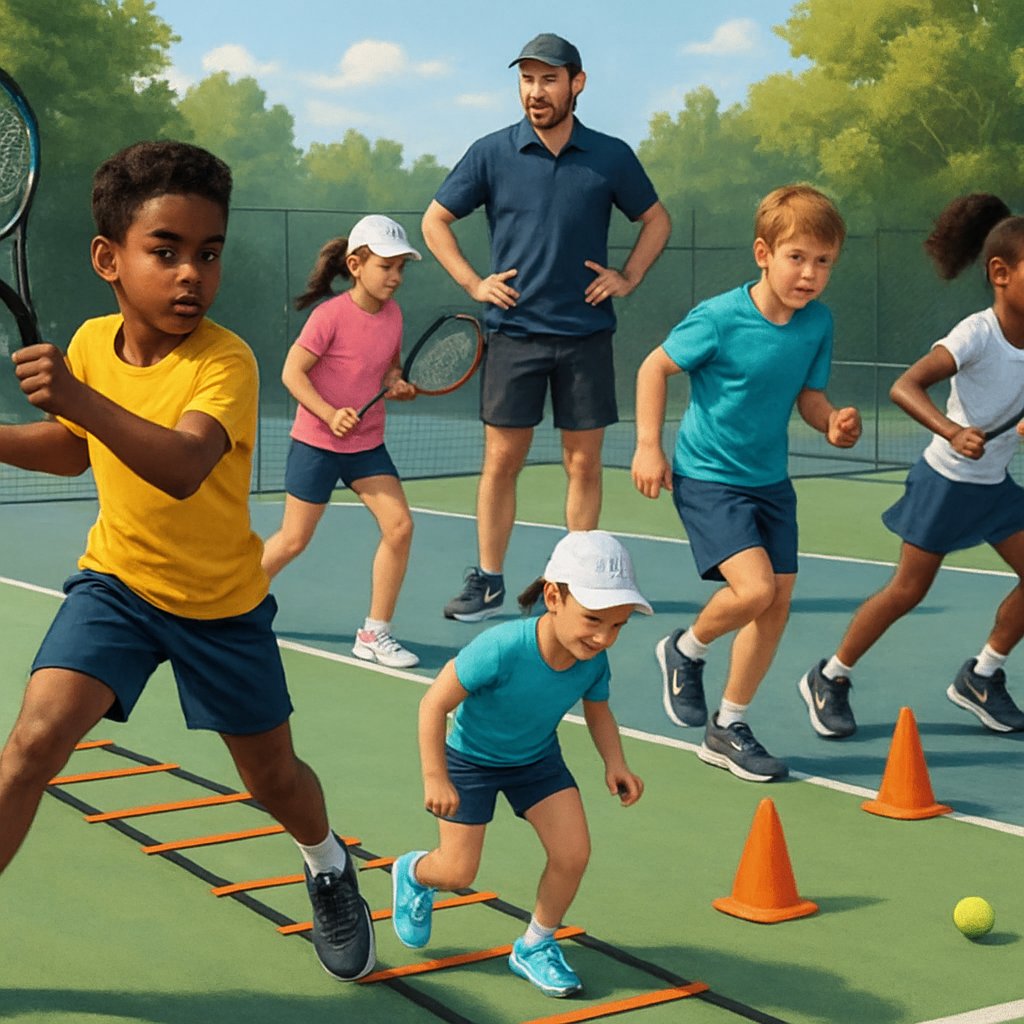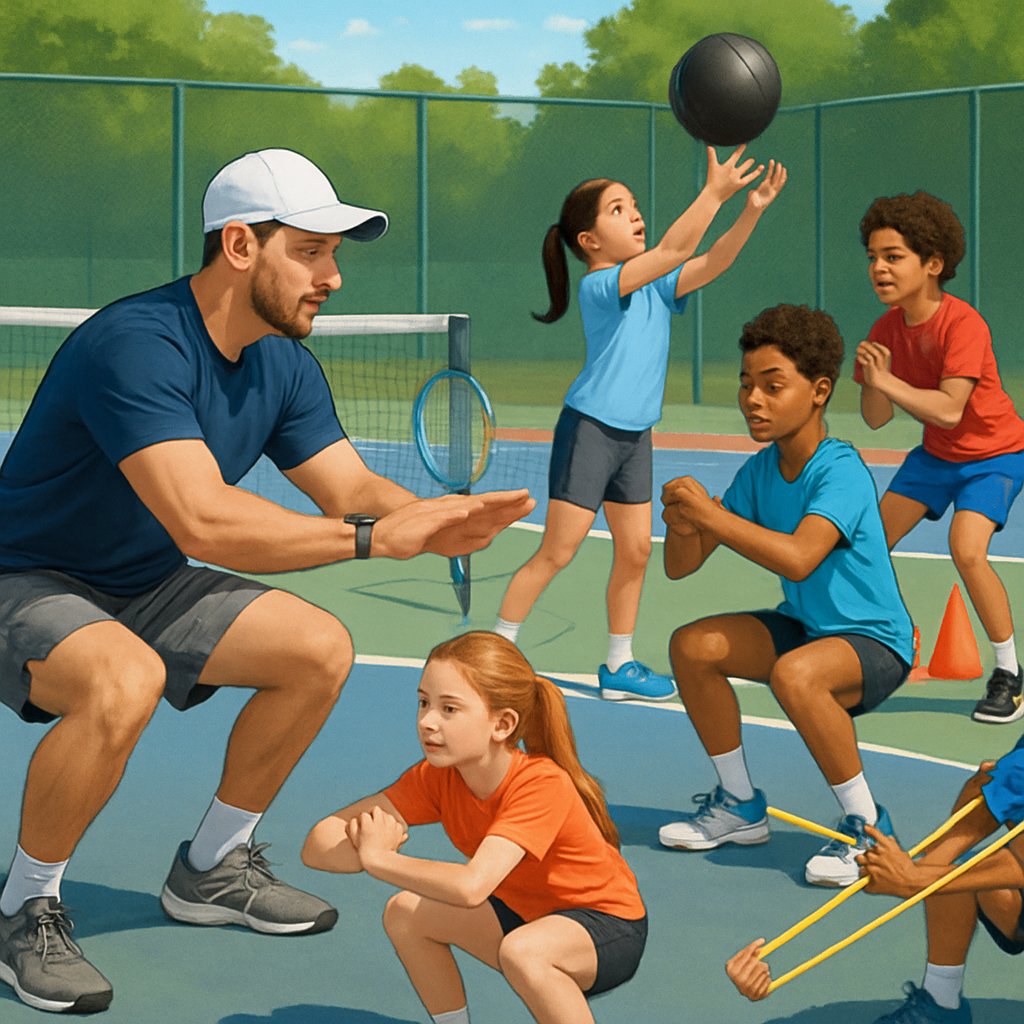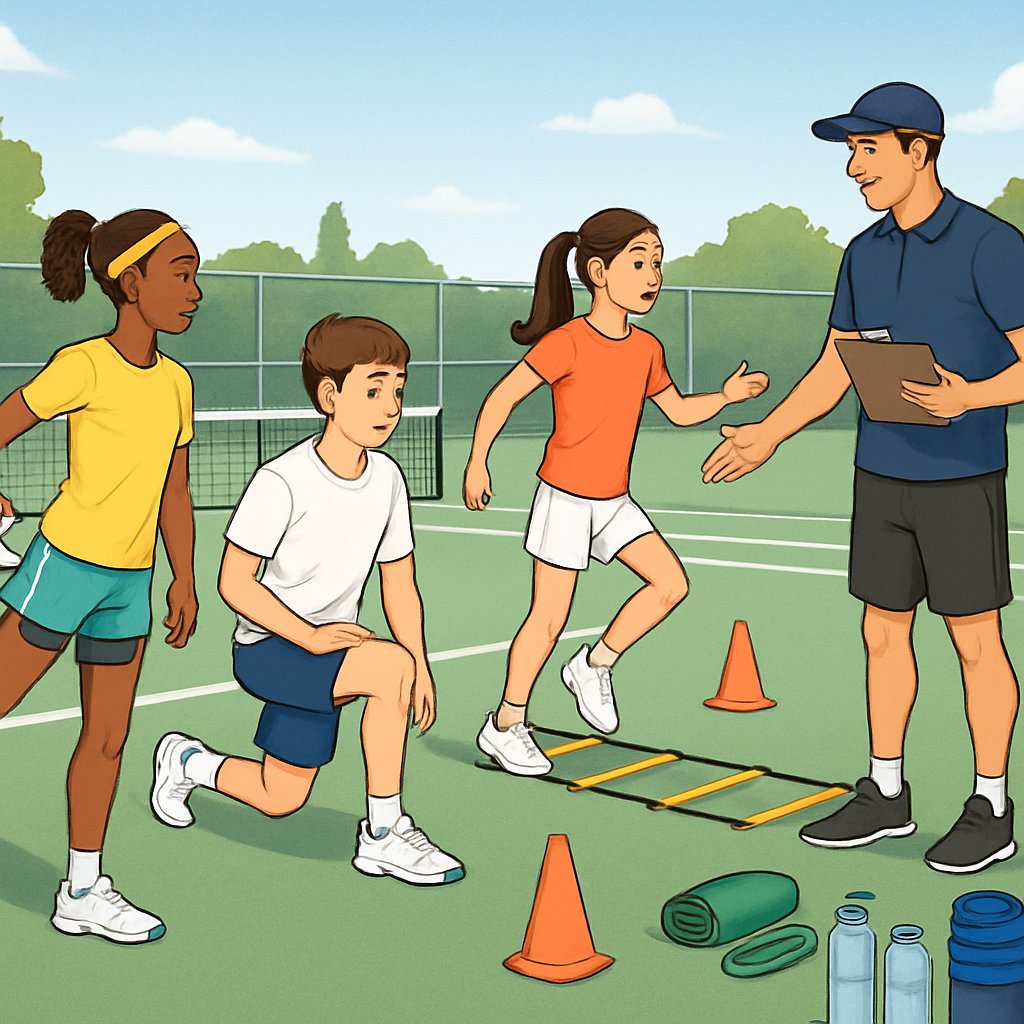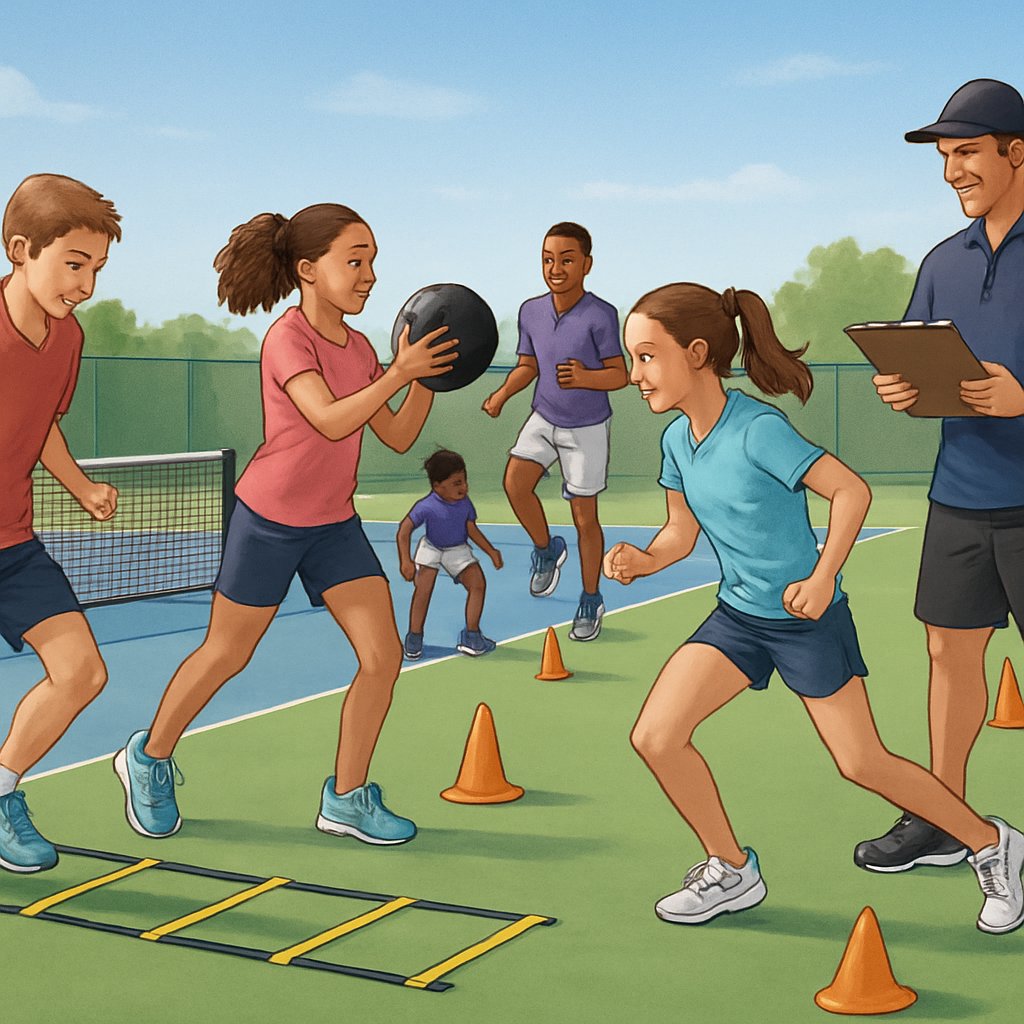Young tennis players need more than just time on the court to reach their full potential. Building a strong athletic foundation through proper conditioning helps young players develop the strength, speed, and movement skills they need to excel while reducing their risk of injury.
Youth Tennis Conditioning is essential for developing the core skills needed for success in the sport.
Tennis demands quick direction changes, powerful swings, and lasting energy throughout long matches.

Many parents and coaches focus only on tennis technique and forget about physical fitness. That mindset limits how much young players can actually improve and puts them at risk for getting hurt.
Incorporating Youth Tennis Conditioning into training plans can enhance overall performance.
A complete conditioning program works on six key areas: strength, power, mobility, movement, conditioning, and coordination.
The right training program makes tennis more fun for kids. When young athletes have strong bodies and good movement skills, they can focus on learning tennis skills instead of fighting their own physical limits.
With Youth Tennis Conditioning, young players can improve their agility and strength.
Key Takeaways
- Youth tennis conditioning focuses on building strength, power, mobility, movement skills, conditioning, and coordination through age-appropriate exercises.
- Youth Tennis Conditioning helps in developing comprehensive athletic skills.
- Proper athletic foundation training reduces injury risk while improving on-court performance and overall movement quality.
- Effective programs combine fun, technically beneficial drills that develop tennis-specific fitness and keep young players engaged.
- Integrating Youth Tennis Conditioning into routines maximizes training efficiency.
Principles of Youth Tennis Conditioning

Effective Youth Tennis Conditioning programs focus on balanced growth across different skill sets.
Young tennis players need training methods that fit their growth stages and skill levels. These principles focus on building a strong foundation through proper development stages, age-matched exercises, and movement skills.
Employing Youth Tennis Conditioning can significantly reduce injury rates.
Long-Term Athletic Development in Tennis
Long-term athletic development follows a step-by-step plan that grows with your young tennis player. This approach builds skills over many years instead of rushing for quick results.
The early stages focus on movement patterns rather than intense training. Your child learns basic skills like running, jumping, and catching before advanced tennis moves.
Tennis-specific skills come later. Young players first master general movement skills that help with all sports activities.
Training programs should match where your child is in their growth. Physical changes during growth spurts affect what exercises work best at different times.
The goal is to create tennis players who stay healthy and enjoy the sport for life. That means avoiding burnout and overuse injuries that come from doing too much too soon.
Importance of Age-Appropriate Training
Maximize the benefits of Youth Tennis Conditioning with proper rest and recovery.
Age-appropriate training means matching exercises to your child’s physical and mental development stage. What works for teenagers can actually harm younger children.
Children under 10 need fun-based activities that build basic movement skills. Games and play-based learning work better than structured drills at this age.
Pre-teens can handle more structure but still need variety in their training. Short sessions with different activities keep them engaged and learning.
Teenagers can begin more serious strength training with proper supervision. Their bodies can handle heavier loads and longer training sessions safely.
Training intensity has to match the child’s development level. Too much intensity too early leads to injuries and loss of interest in tennis.
Developing Coordination and Physical Literacy
Coordination skills form the base for all tennis movements. Young players need to develop balance, timing, and body awareness before learning complex tennis techniques.
Physical literacy means having the movement skills and confidence to be active. This includes basic skills like throwing, catching, and moving in different directions.
Tennis requires hand-eye coordination, footwork, and body positioning. These skills develop through varied movement experiences beyond just tennis practice.
Balance training helps young players control their body during quick direction changes. Simple exercises like standing on one foot build this important skill.
Core strength supports all tennis movements. Age-appropriate exercises help young players develop the stability needed for powerful and accurate shots.
Fundamental Components of Athletic Foundations

Young tennis players need four key physical areas to build their athletic base. These include strength, quick movement skills, court footwork, and healthy range of motion.
Strength and Conditioning for Tennis Players
Strength training for young tennis players focuses on bodyweight exercises and light resistance work. These exercises build the muscle foundation needed for powerful shots and injury prevention.
Bodyweight exercises work best for players under 14 years old. Push-ups develop arm and chest strength for serving.
Squats build leg power for quick direction changes. Planks strengthen your core muscles.
A strong core helps you rotate your body during groundstrokes. It also protects your back from injury.
Resistance bands add challenge without heavy weights. They’re perfect for tennis-specific movements.
You can practice your swing motion with added resistance. Try these key exercises:
- Push-ups (modified on knees if needed)
- Squats and lunges
- Plank holds (30-60 seconds)
- Medicine ball tosses
- Resistance band rotations
Start with 2-3 sets of 8-12 repetitions. Focus on proper form instead of speed or heavy resistance.
Speed and Agility Development
Speed and agility training helps you reach balls faster and change direction quickly. These skills separate good players from great ones on the tennis court.
Linear speed means running straight forward or backward. Practice short sprints of 10-20 yards.
Focus on quick acceleration rather than top speed. Lateral movement is more important in tennis.
You move side to side more often than straight ahead. Practice shuffling and crossover steps.
Try these effective speed drills:
- 10-yard sprints from ready position
- Lateral shuffles along baseline
- Forward and backward runs
- Cone weaving patterns
Train speed and agility 2-3 times per week. Keep sessions short with full recovery between reps.
Agility Drills and Footwork Essentials
Agility drills improve your ability to change direction while staying balanced and in control. Good footwork helps you get to balls in better position.
The split step is the foundation of tennis footwork. Practice landing on both feet as your opponent hits the ball.
This prepares you to move in any direction. Try these essential agility drills:
- Ladder drills for quick feet
- Cone zigzag patterns
- Box drill (four corners)
- Side shuffle with direction changes
Practice these agility drills for 10-15 minutes before hitting sessions. Start slowly and build up speed as your coordination improves.
Flexibility and Mobility in Young Athletes
Flexibility and mobility keep your joints healthy and improve your range of motion. Tennis requires full-body movement in all directions.
Youth Tennis Conditioning emphasizes the importance of flexibility and mobility in young athletes.
Dynamic stretching works best before practice. Leg swings and arm circles prepare your body for movement.
Save static stretching for after training. Focus on these key flexibility areas for tennis:
- Shoulder rotation for serving
- Hip flexibility for low shots
- Ankle mobility for quick steps
- Spine rotation for groundstrokes
Spend 10 minutes on mobility work daily. Pay attention to areas that feel tight or restricted.
Safe and Effective Youth Strength Training

Young tennis players need proper strength training methods that build athletic foundations without risking injury. Starting with basic bodyweight movements, adding resistance bands, and focusing on core stability creates a well-rounded training approach.
Bodyweight Exercises for Beginners
Bodyweight exercises form the foundation of safe strength training for young tennis players. These movements teach proper form and build strength using natural body resistance.
Push-ups develop upper body and core strength essential for powerful serves. Start with wall push-ups for beginners.
Progress to knee push-ups, then full push-ups as strength improves. Squats build leg strength for explosive court movement.
Focus on proper knee tracking and hip hinge patterns. Keep feet shoulder-width apart and lower until thighs are parallel to the floor.
Lunges improve single-leg strength and balance needed for tennis footwork. Step forward into a lunge position, keeping the front knee over the ankle.
Alternate legs for equal development. Planks strengthen the entire core system.
Hold for 15-30 seconds at first, building up to 60 seconds. Keep a straight line from head to heels.
Progressive Resistance and Resistance Bands
Resistance bands provide variable resistance that matches natural strength curves. They offer a safe way to add load without heavy weights that could harm growing bodies.
Incorporating Youth Tennis Conditioning enhances performance during matches.
Band Pull-Aparts strengthen the posterior deltoids and rhomboids. These muscles balance the chest development from serves and forehands.
Pull the band apart at chest level with straight arms. Banded Squats add resistance to bodyweight movements.
Place the band around the thighs just above the knees. This activates the glutes and improves hip stability during the squat motion.
Resistance band rows develop pulling strength to counter the pushing motions in tennis. Attach the band to a stable anchor point.
Explore various techniques within Youth Tennis Conditioning to find what suits your player best.
Pull the handles toward your ribs while squeezing your shoulder blades together. Start with light resistance bands.
Progress to medium resistance as strength improves over several weeks.
Core Strength and Stability Techniques
Core stability provides the foundation for all tennis movements. Strong core muscles transfer power from the legs to the arms during strokes.
Dead bugs teach core control while moving arms and legs independently. Lie on your back with arms extended toward the ceiling.
Slowly lower opposite arm and leg while keeping your back flat. Bird dogs build core stability in a prone position.
Start on hands and knees. Extend opposite arm and leg while maintaining a neutral spine.
Integrating Youth Tennis Conditioning into daily practice can lead to significant improvements.
Hold for 5-10 seconds per side. Side planks target the lateral core muscles used in tennis rotation.
Support your body on one forearm and the side of one foot. Keep your body in a straight line from head to feet.
Preventing Injuries and Supporting Recovery

Young tennis players face unique injury risks because of the sport’s repetitive motions and physical demands. Prevention strategies and recovery protocols help maintain healthy development and set the stage for long-term athletic success.
Injury Prevention Strategies
Proper technique forms the foundation of injury prevention for tennis players. Poor form during serves, forehands, and backhands creates unnecessary stress on joints and muscles.
Work with qualified coaches who focus on correct movement patterns. Focus on gradual skill development, not power-based training, in early stages.
Strength and conditioning programs should target tennis-specific muscle groups:
-
- Rotator cuff muscles for shoulder stability
- Core strength for balance and power transfer
Think about how Youth Tennis Conditioning can target specific muscle groups for overall strength.
- Leg muscles for court movement and injury resilience
Start with bodyweight exercises before adding external resistance. Young athletes need 2-3 strength sessions per week during training periods.
Equipment matters too. Use properly sized rackets with appropriate string tension.
Replace worn court shoes regularly to maintain proper grip and support. Pre-activity warm-ups should include dynamic stretching and tennis-specific movements.
The success of Youth Tennis Conditioning is greatly influenced by proper equipment choices.
Managing Overuse Injuries in Tennis
Tennis creates repetitive stress on shoulders, elbows, and wrists through constant hitting motions. Tennis elbow and shoulder impingement are common overuse concerns.
Watch for warning signs like persistent aches, decreased performance, or pain during specific movements. Address these symptoms immediately rather than playing through discomfort.
Rest periods are essential when overuse symptoms appear. Complete rest may be needed at first, followed by modified training loads.
Cross-training activities like swimming or cycling keep fitness up while reducing tennis-specific stress. Physical therapy can address movement patterns that contribute to overuse problems.
Return to full training gradually after symptoms resolve. Increase practice intensity by no more than 10% per week.
Balancing Training and Recovery in Young Athletes
Recovery needs vary based on training intensity and individual physiology. Young tennis players require more recovery time than adult athletes because they’re still growing.
Sleep is the most important recovery tool. Athletes aged 13-18 need 8-10 hours nightly for proper tissue repair and growth hormone release.
Active recovery sessions using light movement or stretching help maintain flexibility without adding training stress. Schedule these between intense practice days.
Consider how Youth Tennis Conditioning impacts your child’s ability to recover and grow.
Nutrition timing supports recovery when players eat protein and carbohydrates within 30 minutes after training. Staying hydrated also matters during recovery.
Plan training schedules with rest days built in. Young athletes should have at least 1-2 full rest days every week during peak training phases.
Conditioning Practices for On-Court Performance

Implementing Youth Tennis Conditioning practices helps align physical fitness with tennis skills.
Tennis conditioning needs training methods that match the sport’s quick bursts of movement and stop-and-go patterns. Building coordination skills alongside physical fitness creates the athletic foundation young players need for better court performance.
Interval Training for Tennis Conditioning
Interval training really matches the stop-and-go feel of tennis points and the breaks between them. It’s a solid way to build the kind of endurance you actually use on the court.
Discover how interval training within Youth Tennis Conditioning can enhance stamina.
Work-to-Rest Ratios for Young Players:
- Beginners: 1:3 ratio (10 seconds work, 30 seconds rest)
- Intermediate: 1:2 ratio (15 seconds work, 30 seconds rest)
- Advanced: 2:1 ratio (20 seconds work, 10 seconds rest)
Sprint intervals are the go-to for tennis conditioning. Run as hard as you can for the work period, then slow down to a walk or jog while you catch your breath.
Sample Tennis Interval Workout:
- Sprint from baseline to net (5 reps)
- Side shuffle across the court (8 reps)
- Diagonal run from corner to corner (6 reps)
Stick to 2-3 different exercises per session at first. Add more as you start feeling stronger.
Give yourself recovery time between sets that’s about the same as the total work time. That way, you avoid burning out young athletes.
Coordination and Reaction Time Drills
Coordination is key in Youth Tennis Conditioning, leading to improved match performance.
Coordination training helps you react faster to the ball and move better on the court. These skills make a clear difference during matches.
Ladder Drills for Court Movement:
-
- Step two feet in each square (good for basic footwork)
- Side step through the ladder (gets your lateral movement up)
Engaging in Youth Tennis Conditioning drills can sharpen players’ competitive edge.
- In-in-out-out pattern (forces quick changes in direction)
Reaction Ball Training:
Drop a reaction ball on a hard surface and try to catch it after it bounces once. The weird bounce really sharpens your reflexes and hand-eye coordination.
Multi-Ball Coordination:
Have a coach feed balls from all angles, and just focus on getting to each one with good footwork. Forget about hitting winners for now.
Balance and Agility Stations:
Make Youth Tennis Conditioning a regular part of your routine for consistent improvement.
Set up cones in different shapes for cutting drills. Mix in single-leg balance holds between movement exercises.
Practice these drills two or three times a week for about 15-20 minutes. Keeping it short helps players stay focused and not get mentally worn out.
Frequently Asked Questions

Parents and coaches have plenty of questions about building good conditioning programs for kids in tennis. Here are some answers about what to include, how often to train, which exercises to use, when to start, how to help at home, and why early conditioning matters.
What are the fundamental elements of a youth tennis conditioning program?
A well-rounded youth tennis conditioning program covers six big areas: strength, power, mobility, movement, conditioning, and coordination.
That athletic foundation is what supports every bit of footwork and every stroke your child makes out there.
Focus on movement quality and body control before you even think about heavy weights.
Coordination drills help with racket control, and balance exercises set players up for better positioning and smoother shots.
How often should young tennis players engage in conditioning exercises?
Kids should do conditioning exercises two or three times a week. This gives them time to recover and still build up strength.
Adjust intensity as needed—if your child has a tournament coming up, it’s smart to back off a bit.
As training gets harder, recovery days matter even more. Pair lighter conditioning with tough tennis practice days.
Which conditioning exercises are recommended for improving balance and agility in junior tennis players?
Try single-leg stands to build stability for tennis moves. Start with 30 seconds and add movement when ready.
Ladder drills help with foot speed and coordination. At first, focus on quick, light steps instead of going too fast.
Balance boards are great for ankle strength. They help prevent injuries and make court movement smoother.
Cone drills teach direction changes that mimic real tennis points. Set up patterns that look like actual court play.
What age is appropriate to start strength training for youth tennis athletes?
Kids can start basic strength training around age 8. Begin with bodyweight moves and resistance bands.
Teach good movement patterns before introducing any weight. Squats, lunges, and pushes come first.
Rotator cuff exercises are a must for young tennis players. They help keep shoulders healthy.
Always have a qualified trainer watch form. Don’t let kids train with sloppy technique.
How can parents support their children’s development in tennis conditioning at home?
Make a little space for basic exercises—squats and lunges don’t need fancy gear.
Keep an eye on your child’s energy and how quickly they bounce back. If they’re looking tired or losing pep, take a break.
Consistent habits work better than marathon sessions. Short, regular workouts beat random long ones every time.
At home, foster Youth Tennis Conditioning habits to further support your child’s development.
Help out with good food and drinks. Young athletes need the right fuel for both tennis and conditioning.
What are the benefits of introducing conditioning early in a child’s tennis training?
Early conditioning helps kids build habits that prevent injuries. Stronger muscles give joints extra protection from the stresses of tennis.
When kids start conditioning young, they pick up better movement patterns. These habits make a real difference in how they hit strokes and move around the court.
Conditioning isn’t just about tennis—it boosts overall athletic development. Your child gets stronger, more coordinated, and learns how their body moves.
Starting early lays the groundwork for picking up advanced skills down the line. Players who build a solid athletic base tend to pick up complex techniques with less struggle.
The benefits of Youth Tennis Conditioning are vast and contribute to long-term athletic success.
